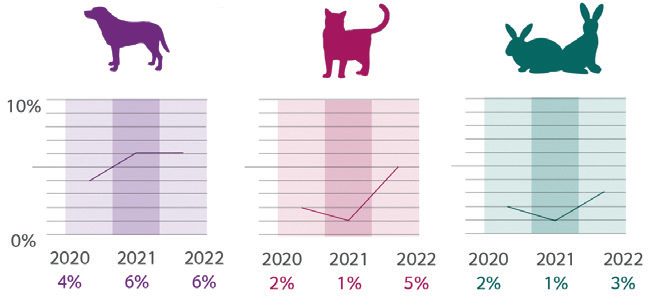Following the introduction of the Animal Welfare Acts (2006, 2011), and in response to a lack of national pet wellbeing surveillance, PDSA, the UK's leading veterinary charity, launched the first PDSA Animal Wellbeing (PAW) Report in 2011. This included a nationally representative survey of UK pet owners and a separate survey of veterinary professionals, providing data on the wellbeing of the nation's owned dogs, cats and rabbits. The annual report explores trends in dog, cat and rabbit owners’ provision of their pets’ welfare needs and current issues and views surrounding pet wellbeing. Reports from 2011 onwards can be downloaded from www.pdsa.org.uk/pawreport and Wensley et al (2021) give a full description of the methodology.
The annual PAW report tracks pet health, welfare and owner views over time, and reveals how pet owners may respond to national pressures and trends (for example, 24% of pet owners acquired their pet in the 2 years following the start of the COVID-19 pandemic in March 2020). The latest survey was distributed between 23 February and 22 March 2022, to 5768 respondents (2569 dog owners, 2586 cat owners and 613 rabbit owners). Key findings are summarised below.
Pet population and acquisitions
The estimated pet population and proportion of UK adults who own pets is calculated each year. In 2022 there were an estimated 11.1 million pet cats, 10.2 million pet dogs and 1 million pet rabbits in the UK (PDSA, 2022). The most common sources of dogs, cats and rabbits in 2022 were: breeders, UK rescue centres and pet shops/garden centres respectively. Between 2020 and 2022 the number of dogs, cats and rabbits acquired from abroad has increased (Figure 1).

Environment
Dog owners were asked about dog walking and concerns, and 17% were concerned about dog-on-dog attacks when on a walk. Cat owners were asked about their pets’ access to indoor and outdoor environments (the majority of cats (70%) had indoor and outdoor access) and opportunities to exercise. Half (51%) of rabbits were housed outdoors, of which 8% lived in a living space classed as inadequate, while 11% of indoor rabbits had inadequate living space.
Diet and weight
In response to questions about food, most owners felt that their dogs (82%), cats (78%) and rabbits (87%) were an ‘ideal weight’, in contrast to research (German et al, 2018) which found that 65% of adult dogs were overweight.
Behaviour
Behaviours displayed by dogs included jumping up at people (29%), barking or vocalising (22%) and growling, snapping at or biting an unfamiliar dog (13%). The most common fears reported in cats were vacuum cleaners (48%) and unfamiliar people (35%). Fear of fireworks was reported in dogs (41%), cats (30%) and rabbits (16%). It was encouraging that the majority of respondents use positive training aids for their dogs including food or treats (73%) and/or toys (60%). However, unfortunately 20% of owners reported using aversive training devices, including electric shock (1%) and prong (1%) collars, equating to approximately 2.1 million dogs in total.
Companionship
On an average weekday, 32% of owners reported that their dog was not left alone, but 15% stated that their dog was alone for 5 hours or longer. Of cats in the UK, 42% live with another cat, including 18% who live with another cat who the owner reports they don't get on with. Despite rabbits being a social species, almost half (46%) of rabbits were reported to be housed alone.
Preventive health
A total of 79% of dogs receive regular booster vaccinations, 76% of cats have been micro-chipped and 11% of rabbits receive no preventive healthcare.
PDSA has collaborated with a range of organisations and universities to further explore the PAW Report data for the benefit of pet health and welfare. A collaboration with the University of Liverpool investigated demographic factors associated with provision of rabbit housing (Mee et al, 2022). Covering multiple pet wellbeing issues, PAW Report data can be helpful in guiding the direction of future research.


